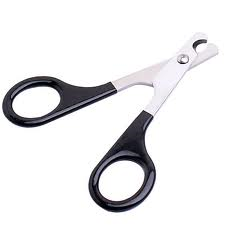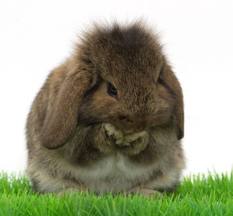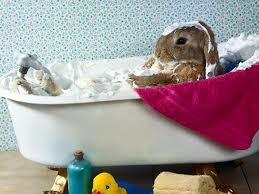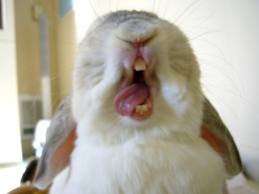Even though rabbits are very clean animals that repeatedly groom themselves, they still need help from their humans to look and feel their best. Grooming time is a good time to get to know your rabbit and check for lumps, fleas, urine burn, sore hocks and other potential problems.
You should groom your rabbit weekly.
Brush more often when your rabbit is shedding or is a long furred breed.
Shedding:
Rabbits molt four times a year, alternating heavy and light sheds. Some rabbits molt very
quickly with an overall full body shed that only lasts a day or two. Others start shedding at
the head, and the shed pattern gradually works its way down the back. Still other rabbits shed
in ‘tufts’, which can be gently plucked off during a daily petting session. Regardless of how your
rabbit sheds, brushing, petting your rabbit with damp hands and gently plucking off loose tufts
of fur are all effective means of removing loose fur. Longhaired breeds and molting rabbits
require more frequent brushings than shorthaired breeds and rabbits not in molt.
Longhaired breeds easily develop mats close to the skin due to their dander, so sometimes it is best to keep their
fur cut short.
Suggested brush/comb type tools for removing loose fur from your pet include:
2. Zoom Groom / rubber grooming gloves.
![]()
3. Plastic or Metal Combs (longhaired breeds)
4. Shedding Blades or Rakes.
Whatever tool you choose, it is important to remove loose hair so that your rabbit doesn’t ingest too much while grooming. Like cats, rabbits spend a lot of time grooming themselves. Unlike cats, rabbits can’t vomit.
Regular grooming will prevent your pet from ingesting too much hair, which can lead to life threatening blockages.
Rabbit skin is very delicate and can tear quite easily. If your rabbit has become matted, it is best to use a mat splitter or a mat rake to gently try to break up the mats. If you are extremely careful, and are able to feel where the skin ends and the mat begins, you can snip into the mat with small grooming (blunt) scissors and gently work at what’s left with a metal comb. A few small snips can help to break the mat apart, making it easier comb out. Be cautious not to brush too vigorously or pull too hard away from the skin, and always hold your fingers between the rabbit’s skin and the scissors. If the mats are too severe, you may have to have your rabbit shaved by your veterinarian. Electric clippers can very easily bruise or scrape a rabbit’s skin even in experienced hands, so this should be a method of last resort.
Bathing can be extremely stressful for a rabbit. For this reason, rabbits should not be bathed. If a part of your rabbit becomes soiled (i.e.: his bottom end from loose stool), you can spot bathe that part of the rabbit.
It is best to use a moistened cloth to clean that area or hold the rabbit’s rear under warm running water and gently remove the soiled parts with your fingers. If bathing is unavoidable,
never immerse the entire rabbit in water. Rather, put enough warm water in the sink so that the level is up to his belly. Sit his back feet in the water and, with your hand under the bunny’s chest, gradually lower his front feet into the sink. Use a small cup and slowly pour water over the rabbit to soak and rinse his body, staying away from his face and ears. Only use warm
water to bathe your pet. If water doesn’t sufficiently clean the bunny, consult a rabbit savvy
veterinarian for a shampoo that is safe to use on your rabbit.
Rabbits take a long time to dry. In the winter or in cold climates, you can use a hair dryer on the low setting (NOT on face or genitals) to help dry the rabbit. Keep the dryer at least 12″ from the bunny.
It is best, however, to towel dry the rabbit and keep him out of drafts, away from the air conditioning vent, etc., until he is thoroughly dry.
*If you find you are having to regularly bathe your rabbit because feces have become stuck to his bottom…read our section on Diet. Sometimes with a correction of diet this can be avoided!*
Nail Triming:
 Like dogs, rabbits need to have their nails cut. Nails that have grown too long can become snagged in the carpet and break, which is very painful. Use a guillotine or scissor-type nail cutter to trim the nails. Nails should be cut every 4-8 weeks, depending upon rate of growth. You can use an emery board (nail file) between cuttings to stop the nails from becoming too sharp.
Like dogs, rabbits need to have their nails cut. Nails that have grown too long can become snagged in the carpet and break, which is very painful. Use a guillotine or scissor-type nail cutter to trim the nails. Nails should be cut every 4-8 weeks, depending upon rate of growth. You can use an emery board (nail file) between cuttings to stop the nails from becoming too sharp.
Nail Trimmers:
When cutting your rabbit’s nails, be careful not to cut the quick (blood vessel inside of the nail). The quick is easy to see inside light coloured toenails, but it can be obscured in darker nails. Holding a flashlight under dark coloured nails will help you see the quick.
Have styptic powder on hand (it is of no use if it isn’t beside you ready to be used) in case the blood vessel is accidentally cut. This will help stop the bleeding.
Different techniques for cutting your pet’s nails include the following:
Trancing:
Cradle your rabbit on his back (like a baby) or in your lap. Gently pet his face and nose to help him relax (this is called ‘trancing’). If your rabbit remains calm, you can cut the nails yourself from this position. If not, have a friend cut the nails while you keep the rabbit tranced. Always be sure to sit on the floor when cutting a tranced bunny’s nails. Some rabbits will come out of the trance with little or no warning. If you are sitting on the floor, the rabbit is less likely to fall from your lap and hurt himself. Try not bring them out of the trance or startle them too quickly, slowly return them to an upright position.
‘Bunny Burrito Wrap’:
Securely wrap the rabbit in a towel (this is called a ‘bunny burrito wrap’), cover their eyes and hold them on your lap, securing them in place with your arm. Pull one foot out of the towel at a time and firmly hold it while clipping each nail. If you use this nail cutting technique, be sure that the rabbit is wrapped securely enough that they can not struggle, but not so tightly that the rabbit is uncomfortable. Covering a rabbits eyes often calms them down.
A Little Help from a Friend:
Have a friend hold the rabbit in a comfortable position while you cut the nails (or vice versa).
You may have to experiment with several different nail cutting techniques before finding the one that you and your rabbit are most comfortable with. If you don’t feel comfortable cutting your rabbit’s nails, you will need to make regular visits to your vet and have them do it.
While cutting the nails, take the opportunity to check the feet for sore hocks. On some rabbits, you will see calluses on the heels. This is
normal, as long as they are pink, and not red, sore or irritated.
Scent Glands:
You should regularly check the underside of your rabbit, making sure their bottom end is clean. Overweight and disabled rabbits will have a difficult time reaching their anus and may often have hardened cecals stuck to their fur. It is also a good idea to check their genital area, and scent glands, which are located on both sides of the genital mound. Occasionally the scent glands will need to be cleaned as well. If you take your thumb and index finger and gently press on the area beside the genital mound, the scent glands will open and become visible. A bit of a pungent odor and some dark waxy material are normal. If the waxy material is hardened, you can gently use a moistened q-tip or soft cloth to soften it and drag it away from the area. Do not dig or irritate this area.
Check the incisors for malocclusion or uneven wear. Report any problems to your vet immediately.
Ears:
Check your rabbit’s ears for wax build up. This is especially important for lop breeds and rear leg amputees. A cotton swab can be used to remove the wax from the outer canal. Don’t go too deep, because you can push wax further down. To clean the ears deep down, use a commercial ear cleaner. Your vet can recommend one that is appropriate for your rabbit.
Also, be sure to check the ears for mites. Mites make the ears appear red, crusty and sore. You may also notice some dark, waxy discharge if your rabbit has ear mites. Often, rabbits with mites will dig excessively at their ears and frequently shake their heads. Ears with a rank odour (possible infection) or ears with pus inside should be checked by your veterinarian immediately.
Eyes:
Your rabbit’s eyes should be clear. If they are tearing, your rabbit should be examined by a veterinarian. Use a warm damp cloth or a tissue to gently wipe away tears. Saline solution (used for contact lenses) can be used to crystallize the tears, which can then be brushed out with a flea comb.s






